Financial Analysis and Recommendations for Tesco Plc
VerifiedAdded on 2021/01/02
|14
|4456
|482
Report
AI Summary
This report provides a comprehensive financial analysis of Tesco Plc, a major UK-based international retail organization. It begins with an overview of Tesco's business operations, market position, and financial structure. The report then delves into key financial areas, including an analysis of the income statement, comprehensive income statement, financial position statement, and cash flow statement. Ratio analysis is performed to assess profitability, liquidity, and solvency, providing insights into Tesco's financial performance over time. The report also examines Tesco's competitors, including ASDA, Sainsbury's, and Morrisons, and evaluates investor perspectives. Furthermore, the report analyzes the company's strategic financial objectives, including the use of adequate pricing methodologies. The analysis is based on Tesco's annual reports and relevant financial data. The report concludes with recommendations for investors and stakeholders, along with an assessment of Tesco's sustainability and corporate social responsibility initiatives.

FINANCE FOR MANGERS
Paraphrase This Document
Need a fresh take? Get an instant paraphrase of this document with our AI Paraphraser
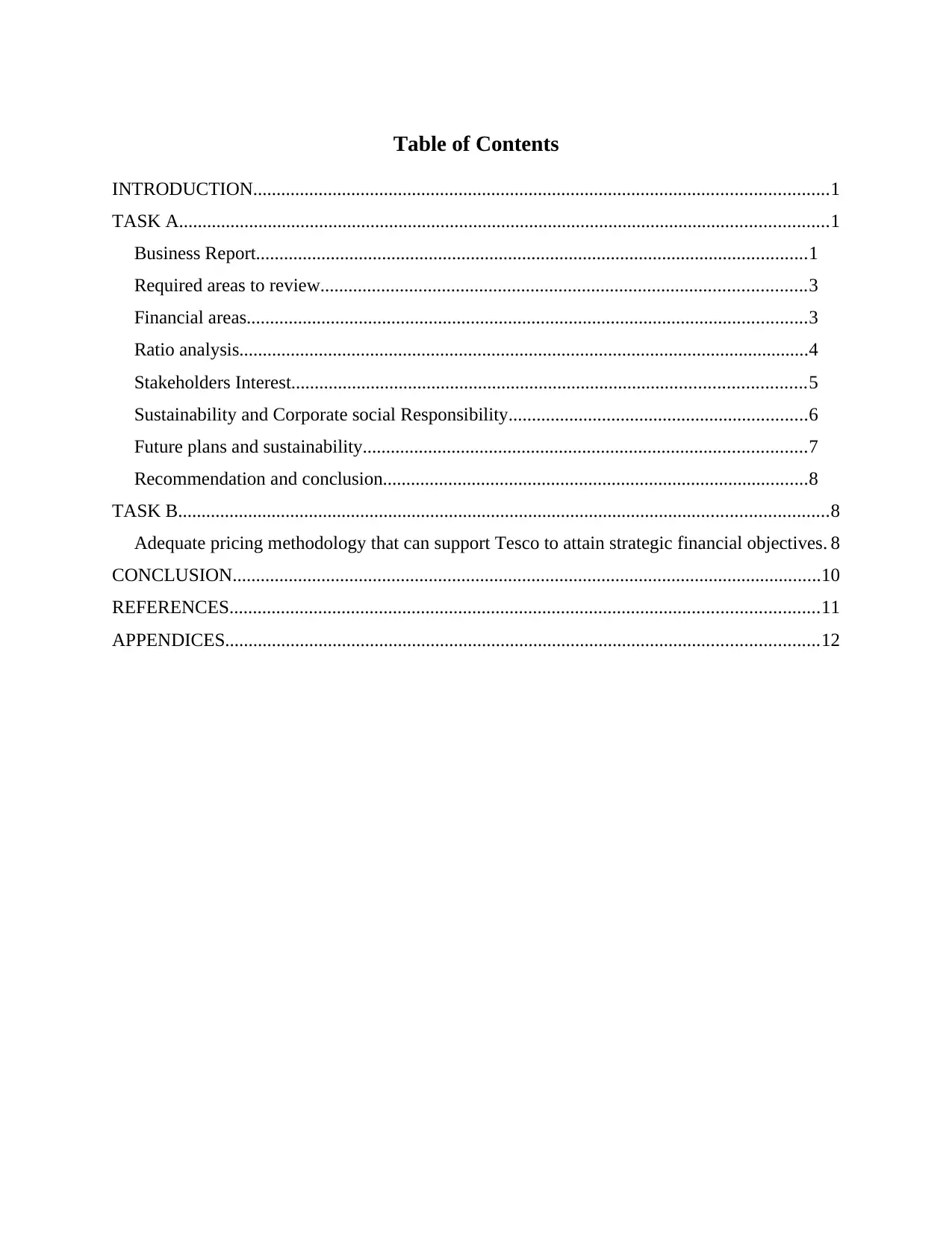
Table of Contents
INTRODUCTION...........................................................................................................................1
TASK A...........................................................................................................................................1
Business Report......................................................................................................................1
Required areas to review........................................................................................................3
Financial areas........................................................................................................................3
Ratio analysis..........................................................................................................................4
Stakeholders Interest..............................................................................................................5
Sustainability and Corporate social Responsibility................................................................6
Future plans and sustainability...............................................................................................7
Recommendation and conclusion...........................................................................................8
TASK B...........................................................................................................................................8
Adequate pricing methodology that can support Tesco to attain strategic financial objectives. 8
CONCLUSION..............................................................................................................................10
REFERENCES..............................................................................................................................11
APPENDICES...............................................................................................................................12
INTRODUCTION...........................................................................................................................1
TASK A...........................................................................................................................................1
Business Report......................................................................................................................1
Required areas to review........................................................................................................3
Financial areas........................................................................................................................3
Ratio analysis..........................................................................................................................4
Stakeholders Interest..............................................................................................................5
Sustainability and Corporate social Responsibility................................................................6
Future plans and sustainability...............................................................................................7
Recommendation and conclusion...........................................................................................8
TASK B...........................................................................................................................................8
Adequate pricing methodology that can support Tesco to attain strategic financial objectives. 8
CONCLUSION..............................................................................................................................10
REFERENCES..............................................................................................................................11
APPENDICES...............................................................................................................................12
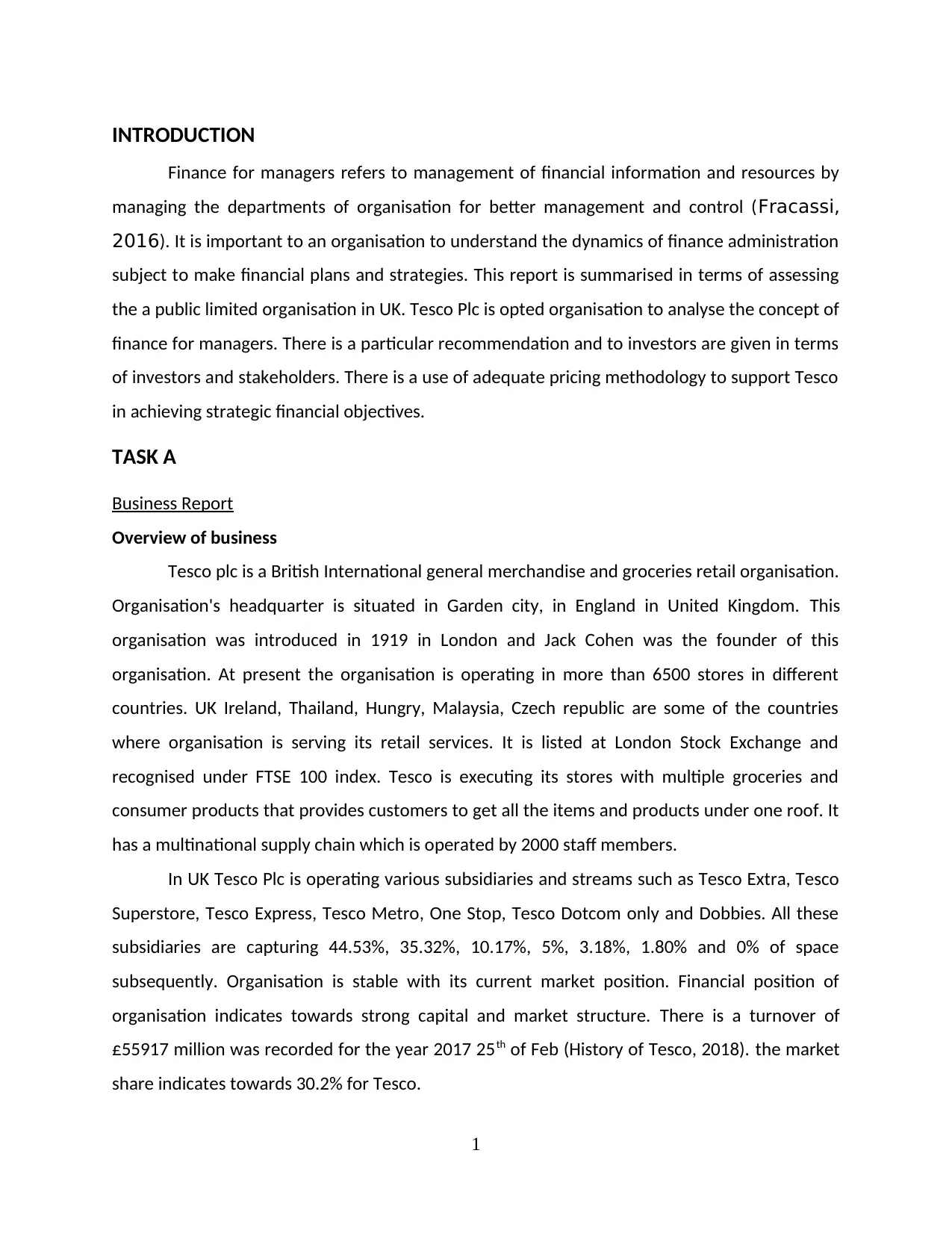
INTRODUCTION
Finance for managers refers to management of financial information and resources by
managing the departments of organisation for better management and control (Fracassi,
2016). It is important to an organisation to understand the dynamics of finance administration
subject to make financial plans and strategies. This report is summarised in terms of assessing
the a public limited organisation in UK. Tesco Plc is opted organisation to analyse the concept of
finance for managers. There is a particular recommendation and to investors are given in terms
of investors and stakeholders. There is a use of adequate pricing methodology to support Tesco
in achieving strategic financial objectives.
TASK A
Business Report
Overview of business
Tesco plc is a British International general merchandise and groceries retail organisation.
Organisation's headquarter is situated in Garden city, in England in United Kingdom. This
organisation was introduced in 1919 in London and Jack Cohen was the founder of this
organisation. At present the organisation is operating in more than 6500 stores in different
countries. UK Ireland, Thailand, Hungry, Malaysia, Czech republic are some of the countries
where organisation is serving its retail services. It is listed at London Stock Exchange and
recognised under FTSE 100 index. Tesco is executing its stores with multiple groceries and
consumer products that provides customers to get all the items and products under one roof. It
has a multinational supply chain which is operated by 2000 staff members.
In UK Tesco Plc is operating various subsidiaries and streams such as Tesco Extra, Tesco
Superstore, Tesco Express, Tesco Metro, One Stop, Tesco Dotcom only and Dobbies. All these
subsidiaries are capturing 44.53%, 35.32%, 10.17%, 5%, 3.18%, 1.80% and 0% of space
subsequently. Organisation is stable with its current market position. Financial position of
organisation indicates towards strong capital and market structure. There is a turnover of
£55917 million was recorded for the year 2017 25th of Feb (History of Tesco, 2018). the market
share indicates towards 30.2% for Tesco.
1
Finance for managers refers to management of financial information and resources by
managing the departments of organisation for better management and control (Fracassi,
2016). It is important to an organisation to understand the dynamics of finance administration
subject to make financial plans and strategies. This report is summarised in terms of assessing
the a public limited organisation in UK. Tesco Plc is opted organisation to analyse the concept of
finance for managers. There is a particular recommendation and to investors are given in terms
of investors and stakeholders. There is a use of adequate pricing methodology to support Tesco
in achieving strategic financial objectives.
TASK A
Business Report
Overview of business
Tesco plc is a British International general merchandise and groceries retail organisation.
Organisation's headquarter is situated in Garden city, in England in United Kingdom. This
organisation was introduced in 1919 in London and Jack Cohen was the founder of this
organisation. At present the organisation is operating in more than 6500 stores in different
countries. UK Ireland, Thailand, Hungry, Malaysia, Czech republic are some of the countries
where organisation is serving its retail services. It is listed at London Stock Exchange and
recognised under FTSE 100 index. Tesco is executing its stores with multiple groceries and
consumer products that provides customers to get all the items and products under one roof. It
has a multinational supply chain which is operated by 2000 staff members.
In UK Tesco Plc is operating various subsidiaries and streams such as Tesco Extra, Tesco
Superstore, Tesco Express, Tesco Metro, One Stop, Tesco Dotcom only and Dobbies. All these
subsidiaries are capturing 44.53%, 35.32%, 10.17%, 5%, 3.18%, 1.80% and 0% of space
subsequently. Organisation is stable with its current market position. Financial position of
organisation indicates towards strong capital and market structure. There is a turnover of
£55917 million was recorded for the year 2017 25th of Feb (History of Tesco, 2018). the market
share indicates towards 30.2% for Tesco.
1
⊘ This is a preview!⊘
Do you want full access?
Subscribe today to unlock all pages.

Trusted by 1+ million students worldwide
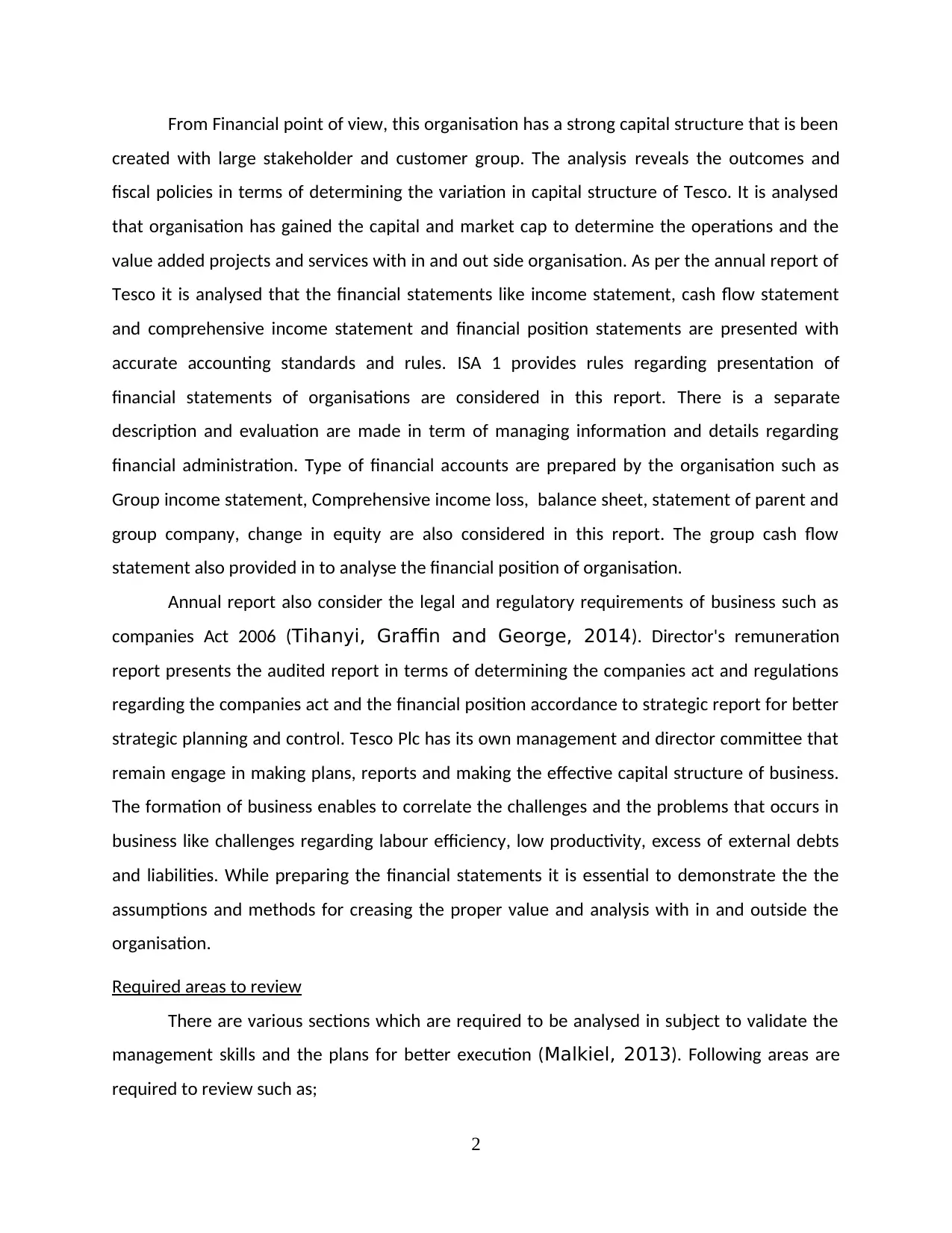
From Financial point of view, this organisation has a strong capital structure that is been
created with large stakeholder and customer group. The analysis reveals the outcomes and
fiscal policies in terms of determining the variation in capital structure of Tesco. It is analysed
that organisation has gained the capital and market cap to determine the operations and the
value added projects and services with in and out side organisation. As per the annual report of
Tesco it is analysed that the financial statements like income statement, cash flow statement
and comprehensive income statement and financial position statements are presented with
accurate accounting standards and rules. ISA 1 provides rules regarding presentation of
financial statements of organisations are considered in this report. There is a separate
description and evaluation are made in term of managing information and details regarding
financial administration. Type of financial accounts are prepared by the organisation such as
Group income statement, Comprehensive income loss, balance sheet, statement of parent and
group company, change in equity are also considered in this report. The group cash flow
statement also provided in to analyse the financial position of organisation.
Annual report also consider the legal and regulatory requirements of business such as
companies Act 2006 (Tihanyi, Graffin and George, 2014). Director's remuneration
report presents the audited report in terms of determining the companies act and regulations
regarding the companies act and the financial position accordance to strategic report for better
strategic planning and control. Tesco Plc has its own management and director committee that
remain engage in making plans, reports and making the effective capital structure of business.
The formation of business enables to correlate the challenges and the problems that occurs in
business like challenges regarding labour efficiency, low productivity, excess of external debts
and liabilities. While preparing the financial statements it is essential to demonstrate the the
assumptions and methods for creasing the proper value and analysis with in and outside the
organisation.
Required areas to review
There are various sections which are required to be analysed in subject to validate the
management skills and the plans for better execution (Malkiel, 2013). Following areas are
required to review such as;
2
created with large stakeholder and customer group. The analysis reveals the outcomes and
fiscal policies in terms of determining the variation in capital structure of Tesco. It is analysed
that organisation has gained the capital and market cap to determine the operations and the
value added projects and services with in and out side organisation. As per the annual report of
Tesco it is analysed that the financial statements like income statement, cash flow statement
and comprehensive income statement and financial position statements are presented with
accurate accounting standards and rules. ISA 1 provides rules regarding presentation of
financial statements of organisations are considered in this report. There is a separate
description and evaluation are made in term of managing information and details regarding
financial administration. Type of financial accounts are prepared by the organisation such as
Group income statement, Comprehensive income loss, balance sheet, statement of parent and
group company, change in equity are also considered in this report. The group cash flow
statement also provided in to analyse the financial position of organisation.
Annual report also consider the legal and regulatory requirements of business such as
companies Act 2006 (Tihanyi, Graffin and George, 2014). Director's remuneration
report presents the audited report in terms of determining the companies act and regulations
regarding the companies act and the financial position accordance to strategic report for better
strategic planning and control. Tesco Plc has its own management and director committee that
remain engage in making plans, reports and making the effective capital structure of business.
The formation of business enables to correlate the challenges and the problems that occurs in
business like challenges regarding labour efficiency, low productivity, excess of external debts
and liabilities. While preparing the financial statements it is essential to demonstrate the the
assumptions and methods for creasing the proper value and analysis with in and outside the
organisation.
Required areas to review
There are various sections which are required to be analysed in subject to validate the
management skills and the plans for better execution (Malkiel, 2013). Following areas are
required to review such as;
2
Paraphrase This Document
Need a fresh take? Get an instant paraphrase of this document with our AI Paraphraser
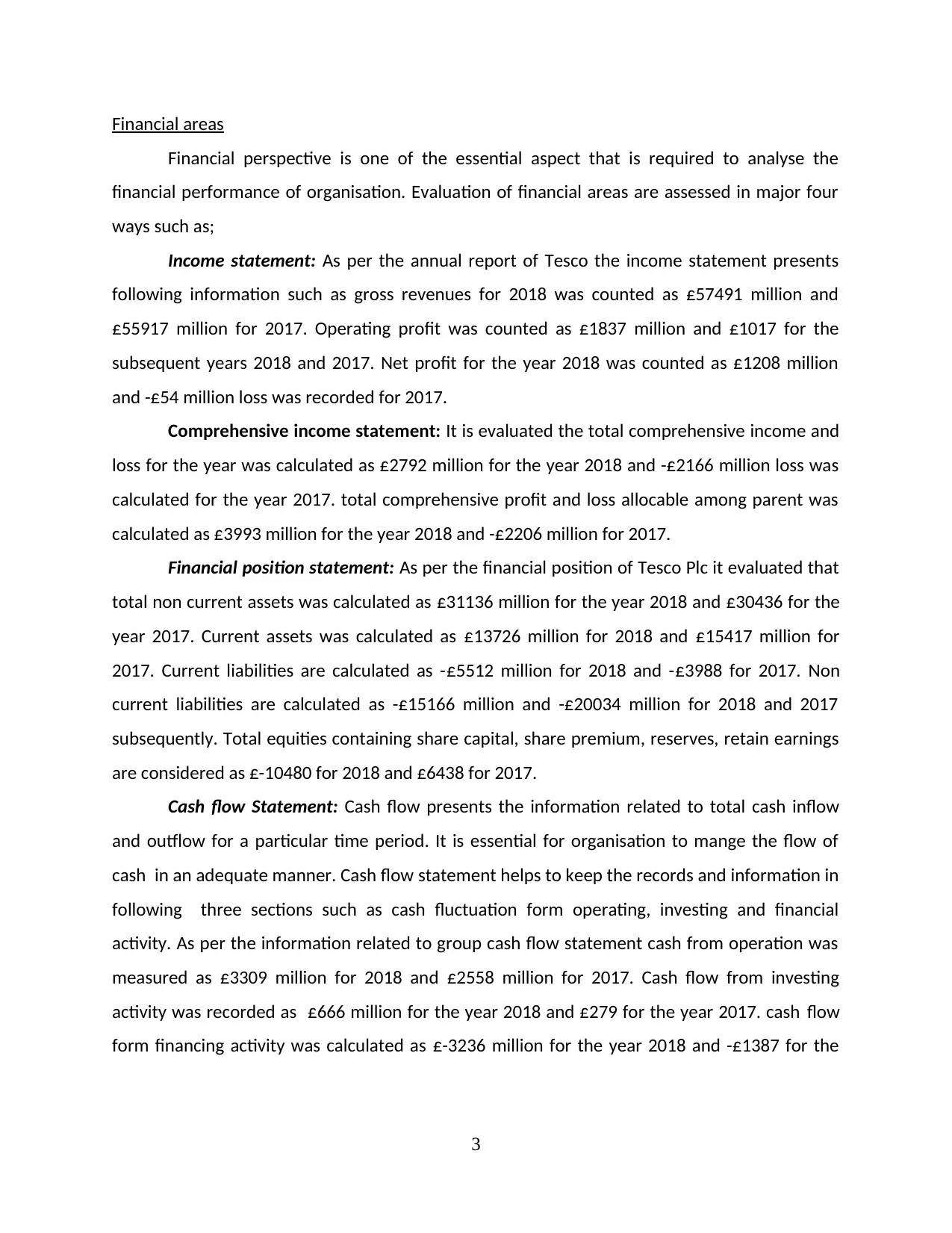
Financial areas
Financial perspective is one of the essential aspect that is required to analyse the
financial performance of organisation. Evaluation of financial areas are assessed in major four
ways such as;
Income statement: As per the annual report of Tesco the income statement presents
following information such as gross revenues for 2018 was counted as £57491 million and
£55917 million for 2017. Operating profit was counted as £1837 million and £1017 for the
subsequent years 2018 and 2017. Net profit for the year 2018 was counted as £1208 million
and -£54 million loss was recorded for 2017.
Comprehensive income statement: It is evaluated the total comprehensive income and
loss for the year was calculated as £2792 million for the year 2018 and -£2166 million loss was
calculated for the year 2017. total comprehensive profit and loss allocable among parent was
calculated as £3993 million for the year 2018 and -£2206 million for 2017.
Financial position statement: As per the financial position of Tesco Plc it evaluated that
total non current assets was calculated as £31136 million for the year 2018 and £30436 for the
year 2017. Current assets was calculated as £13726 million for 2018 and £15417 million for
2017. Current liabilities are calculated as -£5512 million for 2018 and -£3988 for 2017. Non
current liabilities are calculated as -£15166 million and -£20034 million for 2018 and 2017
subsequently. Total equities containing share capital, share premium, reserves, retain earnings
are considered as £-10480 for 2018 and £6438 for 2017.
Cash flow Statement: Cash flow presents the information related to total cash inflow
and outflow for a particular time period. It is essential for organisation to mange the flow of
cash in an adequate manner. Cash flow statement helps to keep the records and information in
following three sections such as cash fluctuation form operating, investing and financial
activity. As per the information related to group cash flow statement cash from operation was
measured as £3309 million for 2018 and £2558 million for 2017. Cash flow from investing
activity was recorded as £666 million for the year 2018 and £279 for the year 2017. cash flow
form financing activity was calculated as £-3236 million for the year 2018 and -£1387 for the
3
Financial perspective is one of the essential aspect that is required to analyse the
financial performance of organisation. Evaluation of financial areas are assessed in major four
ways such as;
Income statement: As per the annual report of Tesco the income statement presents
following information such as gross revenues for 2018 was counted as £57491 million and
£55917 million for 2017. Operating profit was counted as £1837 million and £1017 for the
subsequent years 2018 and 2017. Net profit for the year 2018 was counted as £1208 million
and -£54 million loss was recorded for 2017.
Comprehensive income statement: It is evaluated the total comprehensive income and
loss for the year was calculated as £2792 million for the year 2018 and -£2166 million loss was
calculated for the year 2017. total comprehensive profit and loss allocable among parent was
calculated as £3993 million for the year 2018 and -£2206 million for 2017.
Financial position statement: As per the financial position of Tesco Plc it evaluated that
total non current assets was calculated as £31136 million for the year 2018 and £30436 for the
year 2017. Current assets was calculated as £13726 million for 2018 and £15417 million for
2017. Current liabilities are calculated as -£5512 million for 2018 and -£3988 for 2017. Non
current liabilities are calculated as -£15166 million and -£20034 million for 2018 and 2017
subsequently. Total equities containing share capital, share premium, reserves, retain earnings
are considered as £-10480 for 2018 and £6438 for 2017.
Cash flow Statement: Cash flow presents the information related to total cash inflow
and outflow for a particular time period. It is essential for organisation to mange the flow of
cash in an adequate manner. Cash flow statement helps to keep the records and information in
following three sections such as cash fluctuation form operating, investing and financial
activity. As per the information related to group cash flow statement cash from operation was
measured as £3309 million for 2018 and £2558 million for 2017. Cash flow from investing
activity was recorded as £666 million for the year 2018 and £279 for the year 2017. cash flow
form financing activity was calculated as £-3236 million for the year 2018 and -£1387 for the
3

year 2017. after adjusting the balance cash and cash tequila was calculated as £4059 for the
year 2018 and £3821 for the year 2017 (Annual report of Tesco, 2018).
Ratio analysis
This is also one of the essential technique to analyse the position of organisation in
terms of financial for short term and long term perspective (Ozo and et. al. 2015). There
are type of financial ratios are analysed to determine the capital and liquidity position of Tesco
Plc group in market. Few ratios are calculated as follows;
Profitability ratios: The analysis of financial perspective in term of profitability indicates
towards gross profit margin and net profit margin (Purce, 2014). Gross profit margin was
calculated as 6.01% and 5.83% for 2018 and 2017. net profit margin was calculated as 1.65 for
the year 2018 and 2.10 for the year 2017. Earning before margin was calculated as 2.15 for
2018 and 2.26 for 2017. It is seen that organisation is concerned and effective in terms of its
earning capacity. The policies and aspects are considered more reliable and profitable subject
to continuous improvement and enhancing the earning capacity.
Liquidity ratio: Liquidity position of organisation indicates towards inlaying the
profitability and consistency regarding the changes and development for business operations
and management (Renz, 2016). Current ratio and liquid ratio are the main ratios that are
defined in this ratio to correlate the differences and the management approaches with in
organisational context. As per the liquidity position current ratio of last two years was
calculated as 0.71 and 0.79 for the year 2018 and 2017. liquidity ratio or quick ratio was
calculated as 0.55 and 0.64 for the year 2018 and 2017.
Solvency ratios: This ratio defines the liquidity position of organisation terms of
managing determiner the leverage in capital adequacy and financial leverage and debt equity
ratio (Scholes, 2015). Debt to equity position of Tesco plc shows 0.68:1 for the year 2018
and 1.47:1 2017. financial position of in terms of financial leverage was calculated as 4.28 for
the year 2018 and 7.12 for the year 2017.
Competitors analysis
This company have more than 18 million customers, who shop from ASDA every week.
Currently it is third largest largest retailer in the U.K and it has approx 15.3% market share in
4
year 2018 and £3821 for the year 2017 (Annual report of Tesco, 2018).
Ratio analysis
This is also one of the essential technique to analyse the position of organisation in
terms of financial for short term and long term perspective (Ozo and et. al. 2015). There
are type of financial ratios are analysed to determine the capital and liquidity position of Tesco
Plc group in market. Few ratios are calculated as follows;
Profitability ratios: The analysis of financial perspective in term of profitability indicates
towards gross profit margin and net profit margin (Purce, 2014). Gross profit margin was
calculated as 6.01% and 5.83% for 2018 and 2017. net profit margin was calculated as 1.65 for
the year 2018 and 2.10 for the year 2017. Earning before margin was calculated as 2.15 for
2018 and 2.26 for 2017. It is seen that organisation is concerned and effective in terms of its
earning capacity. The policies and aspects are considered more reliable and profitable subject
to continuous improvement and enhancing the earning capacity.
Liquidity ratio: Liquidity position of organisation indicates towards inlaying the
profitability and consistency regarding the changes and development for business operations
and management (Renz, 2016). Current ratio and liquid ratio are the main ratios that are
defined in this ratio to correlate the differences and the management approaches with in
organisational context. As per the liquidity position current ratio of last two years was
calculated as 0.71 and 0.79 for the year 2018 and 2017. liquidity ratio or quick ratio was
calculated as 0.55 and 0.64 for the year 2018 and 2017.
Solvency ratios: This ratio defines the liquidity position of organisation terms of
managing determiner the leverage in capital adequacy and financial leverage and debt equity
ratio (Scholes, 2015). Debt to equity position of Tesco plc shows 0.68:1 for the year 2018
and 1.47:1 2017. financial position of in terms of financial leverage was calculated as 4.28 for
the year 2018 and 7.12 for the year 2017.
Competitors analysis
This company have more than 18 million customers, who shop from ASDA every week.
Currently it is third largest largest retailer in the U.K and it has approx 15.3% market share in
4
⊘ This is a preview!⊘
Do you want full access?
Subscribe today to unlock all pages.

Trusted by 1+ million students worldwide
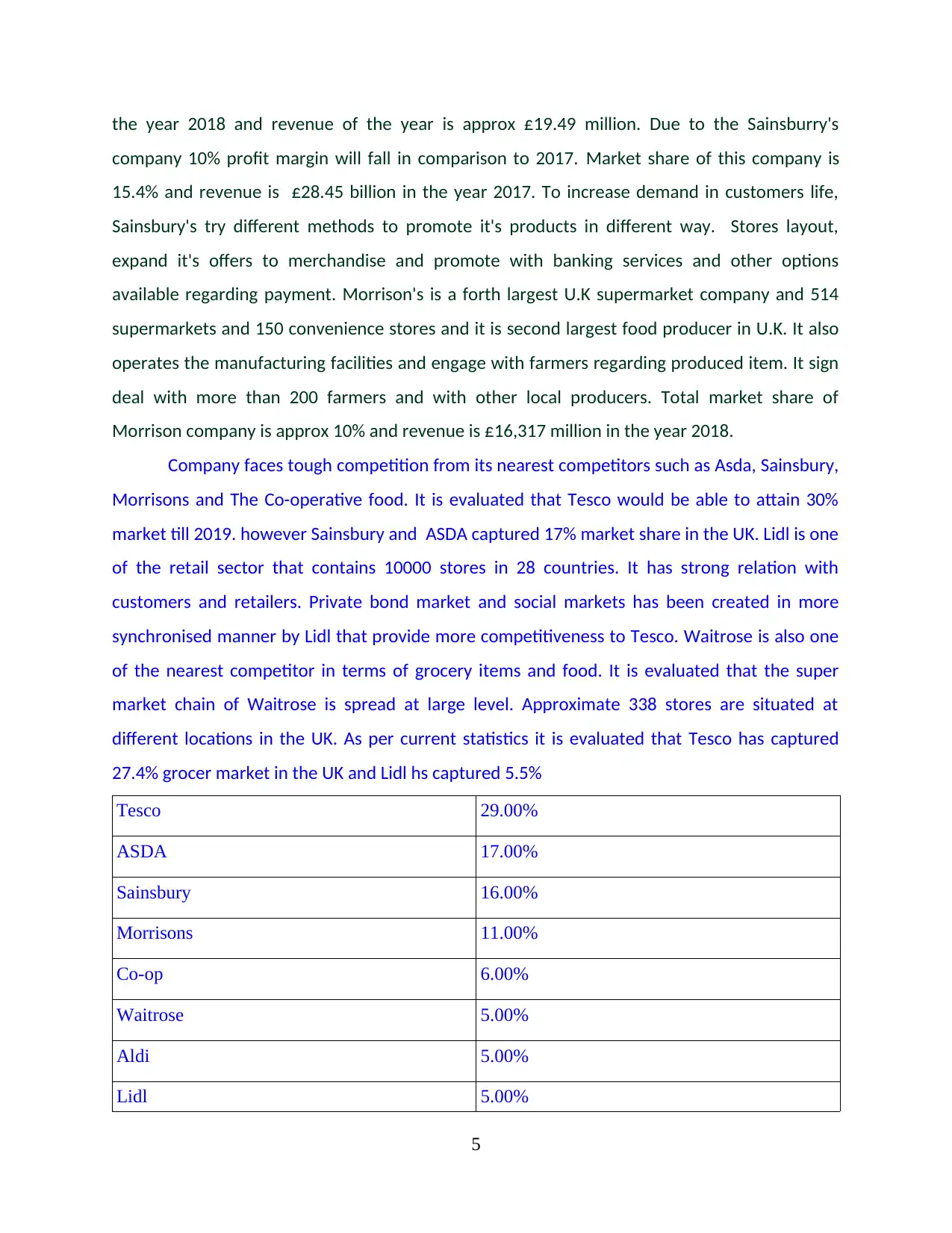
the year 2018 and revenue of the year is approx £19.49 million. Due to the Sainsburry's
company 10% profit margin will fall in comparison to 2017. Market share of this company is
15.4% and revenue is £28.45 billion in the year 2017. To increase demand in customers life,
Sainsbury's try different methods to promote it's products in different way. Stores layout,
expand it's offers to merchandise and promote with banking services and other options
available regarding payment. Morrison's is a forth largest U.K supermarket company and 514
supermarkets and 150 convenience stores and it is second largest food producer in U.K. It also
operates the manufacturing facilities and engage with farmers regarding produced item. It sign
deal with more than 200 farmers and with other local producers. Total market share of
Morrison company is approx 10% and revenue is £16,317 million in the year 2018.
Company faces tough competition from its nearest competitors such as Asda, Sainsbury,
Morrisons and The Co-operative food. It is evaluated that Tesco would be able to attain 30%
market till 2019. however Sainsbury and ASDA captured 17% market share in the UK. Lidl is one
of the retail sector that contains 10000 stores in 28 countries. It has strong relation with
customers and retailers. Private bond market and social markets has been created in more
synchronised manner by Lidl that provide more competitiveness to Tesco. Waitrose is also one
of the nearest competitor in terms of grocery items and food. It is evaluated that the super
market chain of Waitrose is spread at large level. Approximate 338 stores are situated at
different locations in the UK. As per current statistics it is evaluated that Tesco has captured
27.4% grocer market in the UK and Lidl hs captured 5.5%
Tesco 29.00%
ASDA 17.00%
Sainsbury 16.00%
Morrisons 11.00%
Co-op 6.00%
Waitrose 5.00%
Aldi 5.00%
Lidl 5.00%
5
company 10% profit margin will fall in comparison to 2017. Market share of this company is
15.4% and revenue is £28.45 billion in the year 2017. To increase demand in customers life,
Sainsbury's try different methods to promote it's products in different way. Stores layout,
expand it's offers to merchandise and promote with banking services and other options
available regarding payment. Morrison's is a forth largest U.K supermarket company and 514
supermarkets and 150 convenience stores and it is second largest food producer in U.K. It also
operates the manufacturing facilities and engage with farmers regarding produced item. It sign
deal with more than 200 farmers and with other local producers. Total market share of
Morrison company is approx 10% and revenue is £16,317 million in the year 2018.
Company faces tough competition from its nearest competitors such as Asda, Sainsbury,
Morrisons and The Co-operative food. It is evaluated that Tesco would be able to attain 30%
market till 2019. however Sainsbury and ASDA captured 17% market share in the UK. Lidl is one
of the retail sector that contains 10000 stores in 28 countries. It has strong relation with
customers and retailers. Private bond market and social markets has been created in more
synchronised manner by Lidl that provide more competitiveness to Tesco. Waitrose is also one
of the nearest competitor in terms of grocery items and food. It is evaluated that the super
market chain of Waitrose is spread at large level. Approximate 338 stores are situated at
different locations in the UK. As per current statistics it is evaluated that Tesco has captured
27.4% grocer market in the UK and Lidl hs captured 5.5%
Tesco 29.00%
ASDA 17.00%
Sainsbury 16.00%
Morrisons 11.00%
Co-op 6.00%
Waitrose 5.00%
Aldi 5.00%
Lidl 5.00%
5
Paraphrase This Document
Need a fresh take? Get an instant paraphrase of this document with our AI Paraphraser
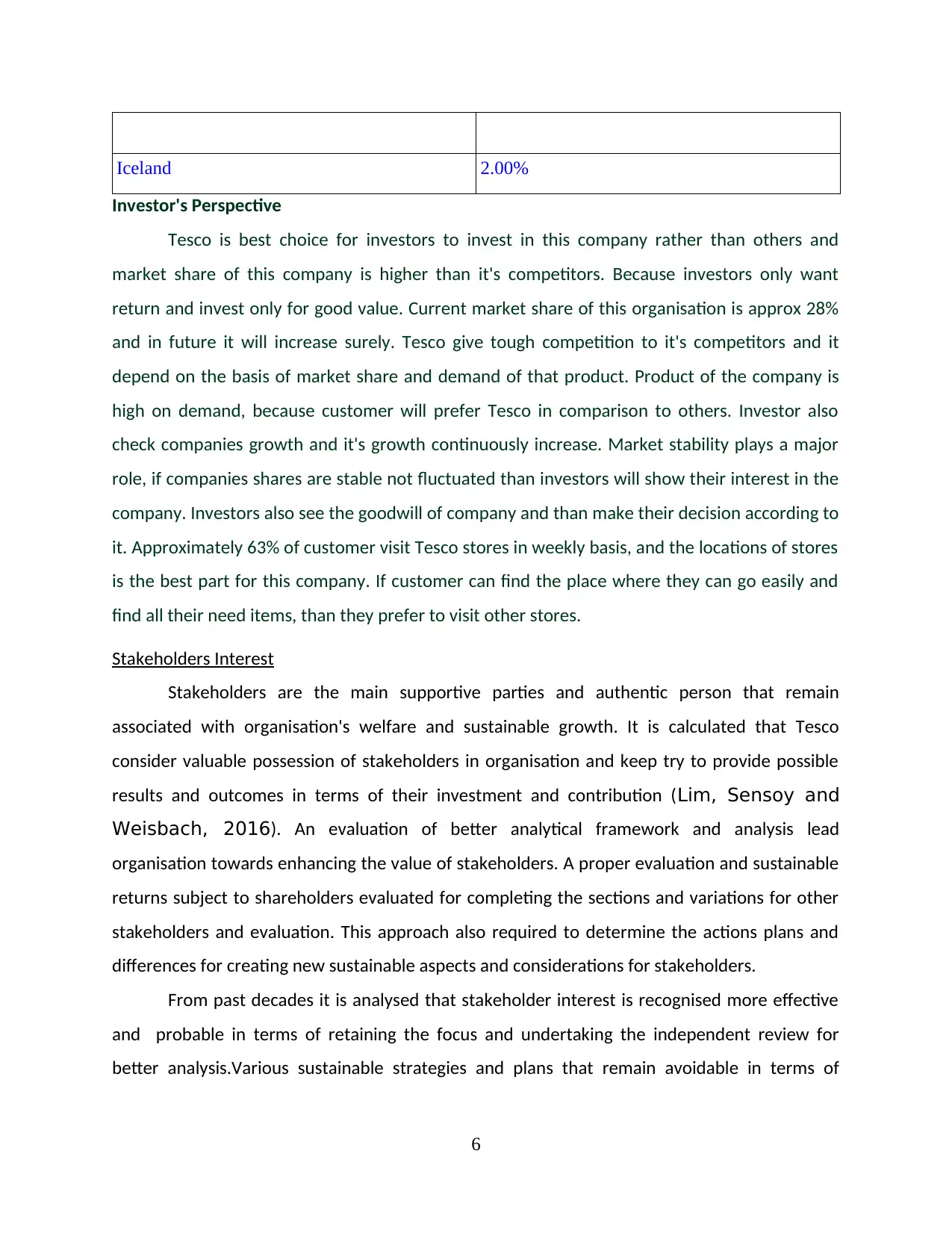
Iceland 2.00%
Investor's Perspective
Tesco is best choice for investors to invest in this company rather than others and
market share of this company is higher than it's competitors. Because investors only want
return and invest only for good value. Current market share of this organisation is approx 28%
and in future it will increase surely. Tesco give tough competition to it's competitors and it
depend on the basis of market share and demand of that product. Product of the company is
high on demand, because customer will prefer Tesco in comparison to others. Investor also
check companies growth and it's growth continuously increase. Market stability plays a major
role, if companies shares are stable not fluctuated than investors will show their interest in the
company. Investors also see the goodwill of company and than make their decision according to
it. Approximately 63% of customer visit Tesco stores in weekly basis, and the locations of stores
is the best part for this company. If customer can find the place where they can go easily and
find all their need items, than they prefer to visit other stores.
Stakeholders Interest
Stakeholders are the main supportive parties and authentic person that remain
associated with organisation's welfare and sustainable growth. It is calculated that Tesco
consider valuable possession of stakeholders in organisation and keep try to provide possible
results and outcomes in terms of their investment and contribution (Lim, Sensoy and
Weisbach, 2016). An evaluation of better analytical framework and analysis lead
organisation towards enhancing the value of stakeholders. A proper evaluation and sustainable
returns subject to shareholders evaluated for completing the sections and variations for other
stakeholders and evaluation. This approach also required to determine the actions plans and
differences for creating new sustainable aspects and considerations for stakeholders.
From past decades it is analysed that stakeholder interest is recognised more effective
and probable in terms of retaining the focus and undertaking the independent review for
better analysis.Various sustainable strategies and plans that remain avoidable in terms of
6
Investor's Perspective
Tesco is best choice for investors to invest in this company rather than others and
market share of this company is higher than it's competitors. Because investors only want
return and invest only for good value. Current market share of this organisation is approx 28%
and in future it will increase surely. Tesco give tough competition to it's competitors and it
depend on the basis of market share and demand of that product. Product of the company is
high on demand, because customer will prefer Tesco in comparison to others. Investor also
check companies growth and it's growth continuously increase. Market stability plays a major
role, if companies shares are stable not fluctuated than investors will show their interest in the
company. Investors also see the goodwill of company and than make their decision according to
it. Approximately 63% of customer visit Tesco stores in weekly basis, and the locations of stores
is the best part for this company. If customer can find the place where they can go easily and
find all their need items, than they prefer to visit other stores.
Stakeholders Interest
Stakeholders are the main supportive parties and authentic person that remain
associated with organisation's welfare and sustainable growth. It is calculated that Tesco
consider valuable possession of stakeholders in organisation and keep try to provide possible
results and outcomes in terms of their investment and contribution (Lim, Sensoy and
Weisbach, 2016). An evaluation of better analytical framework and analysis lead
organisation towards enhancing the value of stakeholders. A proper evaluation and sustainable
returns subject to shareholders evaluated for completing the sections and variations for other
stakeholders and evaluation. This approach also required to determine the actions plans and
differences for creating new sustainable aspects and considerations for stakeholders.
From past decades it is analysed that stakeholder interest is recognised more effective
and probable in terms of retaining the focus and undertaking the independent review for
better analysis.Various sustainable strategies and plans that remain avoidable in terms of
6
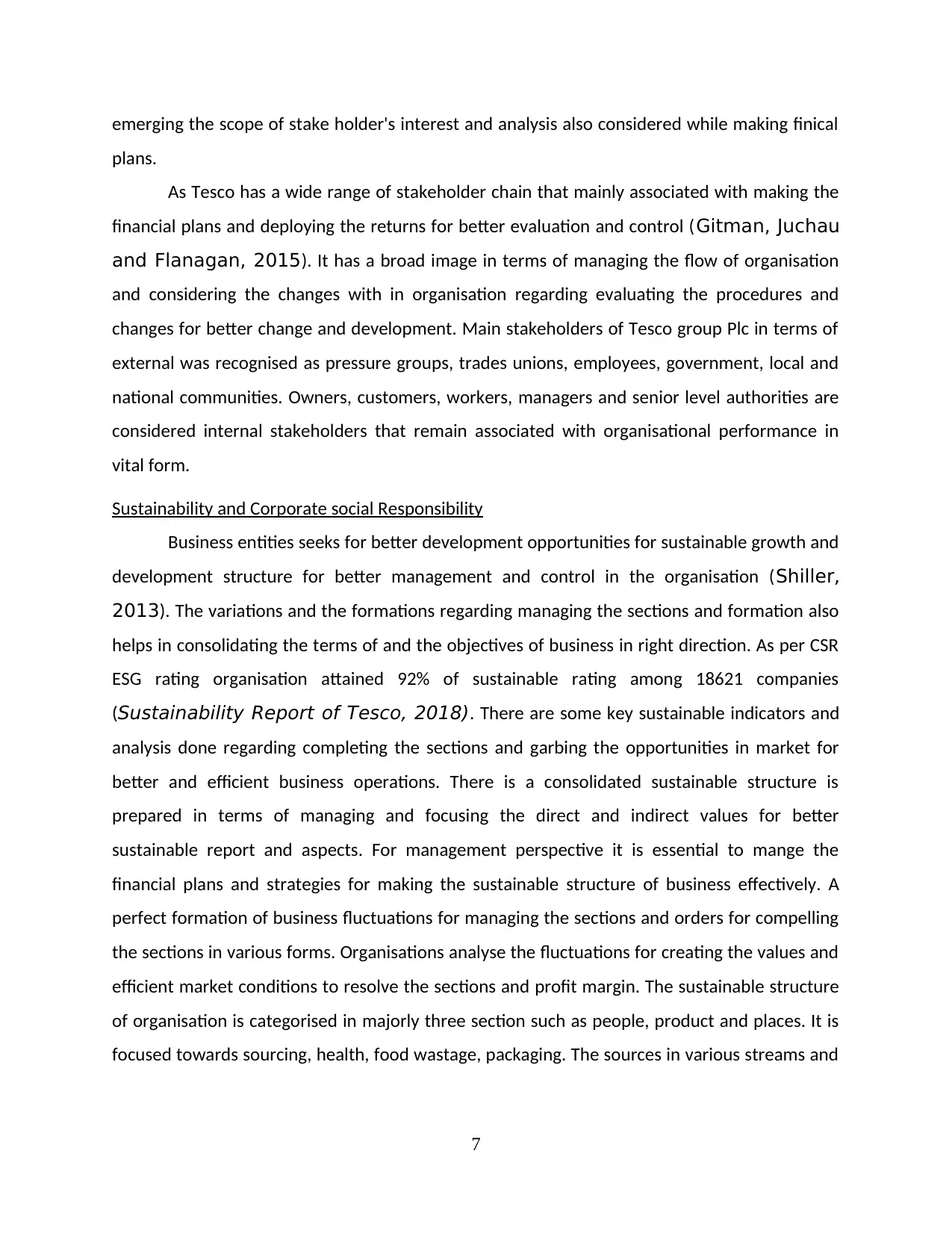
emerging the scope of stake holder's interest and analysis also considered while making finical
plans.
As Tesco has a wide range of stakeholder chain that mainly associated with making the
financial plans and deploying the returns for better evaluation and control (Gitman, Juchau
and Flanagan, 2015). It has a broad image in terms of managing the flow of organisation
and considering the changes with in organisation regarding evaluating the procedures and
changes for better change and development. Main stakeholders of Tesco group Plc in terms of
external was recognised as pressure groups, trades unions, employees, government, local and
national communities. Owners, customers, workers, managers and senior level authorities are
considered internal stakeholders that remain associated with organisational performance in
vital form.
Sustainability and Corporate social Responsibility
Business entities seeks for better development opportunities for sustainable growth and
development structure for better management and control in the organisation (Shiller,
2013). The variations and the formations regarding managing the sections and formation also
helps in consolidating the terms of and the objectives of business in right direction. As per CSR
ESG rating organisation attained 92% of sustainable rating among 18621 companies
(Sustainability Report of Tesco, 2018). There are some key sustainable indicators and
analysis done regarding completing the sections and garbing the opportunities in market for
better and efficient business operations. There is a consolidated sustainable structure is
prepared in terms of managing and focusing the direct and indirect values for better
sustainable report and aspects. For management perspective it is essential to mange the
financial plans and strategies for making the sustainable structure of business effectively. A
perfect formation of business fluctuations for managing the sections and orders for compelling
the sections in various forms. Organisations analyse the fluctuations for creating the values and
efficient market conditions to resolve the sections and profit margin. The sustainable structure
of organisation is categorised in majorly three section such as people, product and places. It is
focused towards sourcing, health, food wastage, packaging. The sources in various streams and
7
plans.
As Tesco has a wide range of stakeholder chain that mainly associated with making the
financial plans and deploying the returns for better evaluation and control (Gitman, Juchau
and Flanagan, 2015). It has a broad image in terms of managing the flow of organisation
and considering the changes with in organisation regarding evaluating the procedures and
changes for better change and development. Main stakeholders of Tesco group Plc in terms of
external was recognised as pressure groups, trades unions, employees, government, local and
national communities. Owners, customers, workers, managers and senior level authorities are
considered internal stakeholders that remain associated with organisational performance in
vital form.
Sustainability and Corporate social Responsibility
Business entities seeks for better development opportunities for sustainable growth and
development structure for better management and control in the organisation (Shiller,
2013). The variations and the formations regarding managing the sections and formation also
helps in consolidating the terms of and the objectives of business in right direction. As per CSR
ESG rating organisation attained 92% of sustainable rating among 18621 companies
(Sustainability Report of Tesco, 2018). There are some key sustainable indicators and
analysis done regarding completing the sections and garbing the opportunities in market for
better and efficient business operations. There is a consolidated sustainable structure is
prepared in terms of managing and focusing the direct and indirect values for better
sustainable report and aspects. For management perspective it is essential to mange the
financial plans and strategies for making the sustainable structure of business effectively. A
perfect formation of business fluctuations for managing the sections and orders for compelling
the sections in various forms. Organisations analyse the fluctuations for creating the values and
efficient market conditions to resolve the sections and profit margin. The sustainable structure
of organisation is categorised in majorly three section such as people, product and places. It is
focused towards sourcing, health, food wastage, packaging. The sources in various streams and
7
⊘ This is a preview!⊘
Do you want full access?
Subscribe today to unlock all pages.

Trusted by 1+ million students worldwide
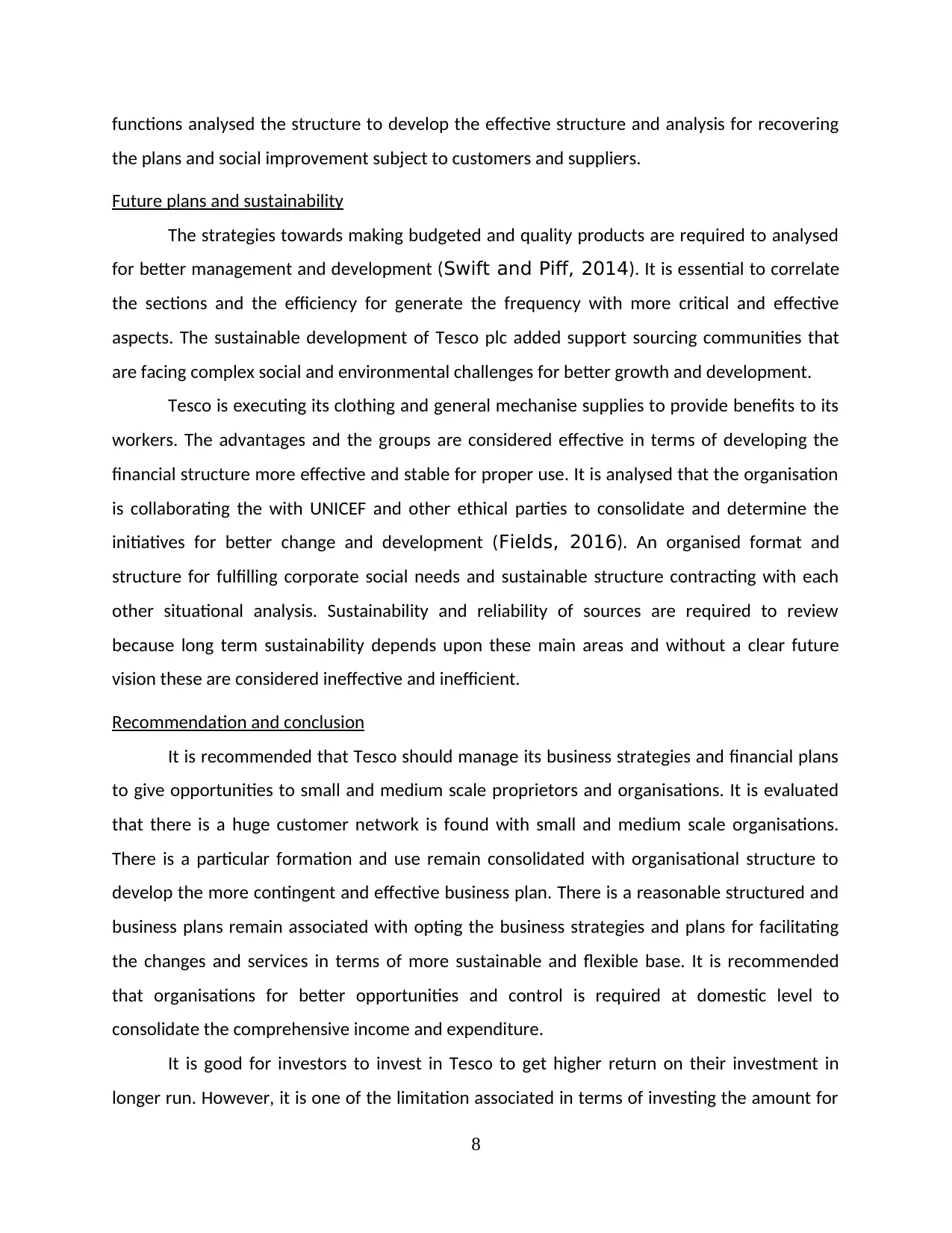
functions analysed the structure to develop the effective structure and analysis for recovering
the plans and social improvement subject to customers and suppliers.
Future plans and sustainability
The strategies towards making budgeted and quality products are required to analysed
for better management and development (Swift and Piff, 2014). It is essential to correlate
the sections and the efficiency for generate the frequency with more critical and effective
aspects. The sustainable development of Tesco plc added support sourcing communities that
are facing complex social and environmental challenges for better growth and development.
Tesco is executing its clothing and general mechanise supplies to provide benefits to its
workers. The advantages and the groups are considered effective in terms of developing the
financial structure more effective and stable for proper use. It is analysed that the organisation
is collaborating the with UNICEF and other ethical parties to consolidate and determine the
initiatives for better change and development (Fields, 2016). An organised format and
structure for fulfilling corporate social needs and sustainable structure contracting with each
other situational analysis. Sustainability and reliability of sources are required to review
because long term sustainability depends upon these main areas and without a clear future
vision these are considered ineffective and inefficient.
Recommendation and conclusion
It is recommended that Tesco should manage its business strategies and financial plans
to give opportunities to small and medium scale proprietors and organisations. It is evaluated
that there is a huge customer network is found with small and medium scale organisations.
There is a particular formation and use remain consolidated with organisational structure to
develop the more contingent and effective business plan. There is a reasonable structured and
business plans remain associated with opting the business strategies and plans for facilitating
the changes and services in terms of more sustainable and flexible base. It is recommended
that organisations for better opportunities and control is required at domestic level to
consolidate the comprehensive income and expenditure.
It is good for investors to invest in Tesco to get higher return on their investment in
longer run. However, it is one of the limitation associated in terms of investing the amount for
8
the plans and social improvement subject to customers and suppliers.
Future plans and sustainability
The strategies towards making budgeted and quality products are required to analysed
for better management and development (Swift and Piff, 2014). It is essential to correlate
the sections and the efficiency for generate the frequency with more critical and effective
aspects. The sustainable development of Tesco plc added support sourcing communities that
are facing complex social and environmental challenges for better growth and development.
Tesco is executing its clothing and general mechanise supplies to provide benefits to its
workers. The advantages and the groups are considered effective in terms of developing the
financial structure more effective and stable for proper use. It is analysed that the organisation
is collaborating the with UNICEF and other ethical parties to consolidate and determine the
initiatives for better change and development (Fields, 2016). An organised format and
structure for fulfilling corporate social needs and sustainable structure contracting with each
other situational analysis. Sustainability and reliability of sources are required to review
because long term sustainability depends upon these main areas and without a clear future
vision these are considered ineffective and inefficient.
Recommendation and conclusion
It is recommended that Tesco should manage its business strategies and financial plans
to give opportunities to small and medium scale proprietors and organisations. It is evaluated
that there is a huge customer network is found with small and medium scale organisations.
There is a particular formation and use remain consolidated with organisational structure to
develop the more contingent and effective business plan. There is a reasonable structured and
business plans remain associated with opting the business strategies and plans for facilitating
the changes and services in terms of more sustainable and flexible base. It is recommended
that organisations for better opportunities and control is required at domestic level to
consolidate the comprehensive income and expenditure.
It is good for investors to invest in Tesco to get higher return on their investment in
longer run. However, it is one of the limitation associated in terms of investing the amount for
8
Paraphrase This Document
Need a fresh take? Get an instant paraphrase of this document with our AI Paraphraser
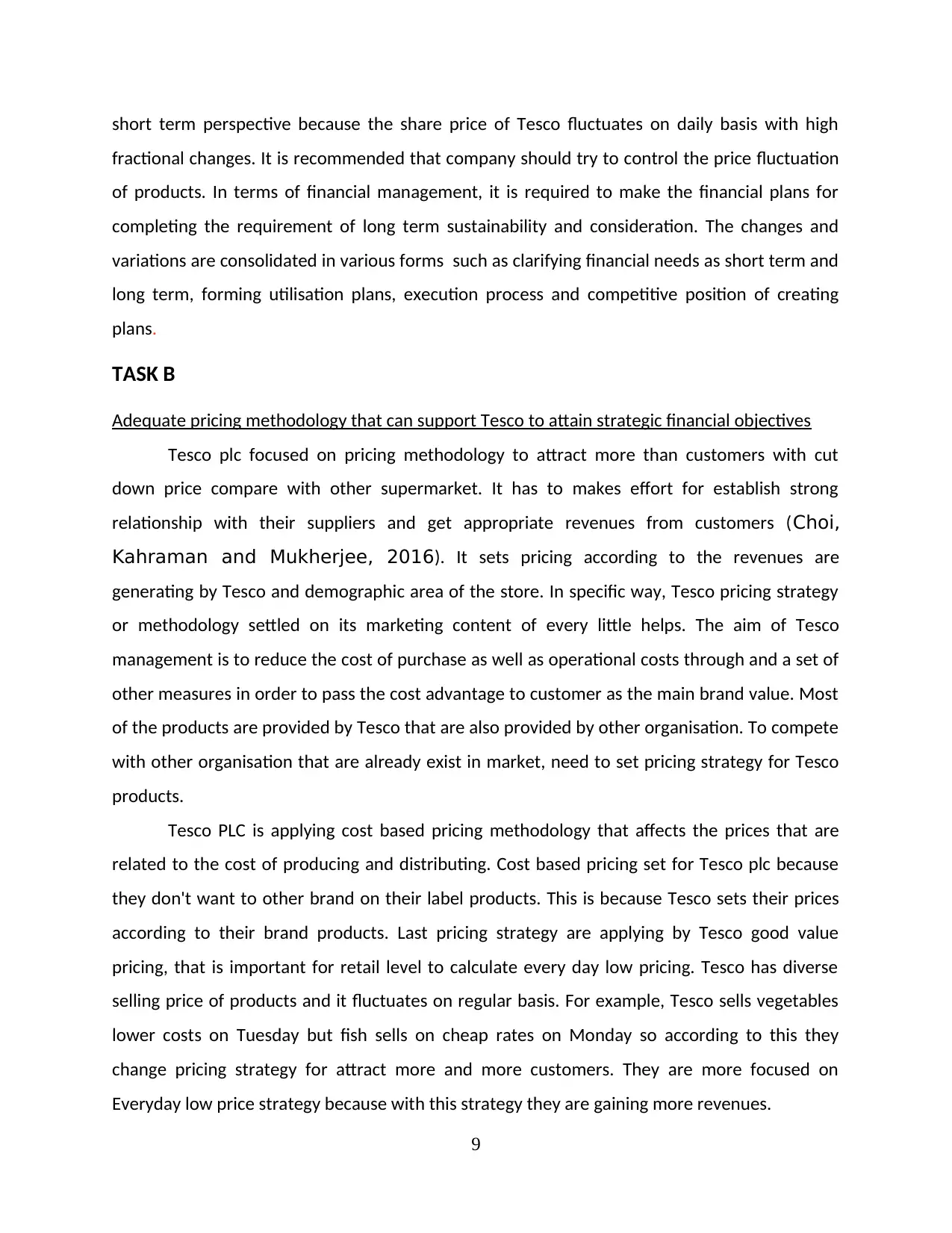
short term perspective because the share price of Tesco fluctuates on daily basis with high
fractional changes. It is recommended that company should try to control the price fluctuation
of products. In terms of financial management, it is required to make the financial plans for
completing the requirement of long term sustainability and consideration. The changes and
variations are consolidated in various forms such as clarifying financial needs as short term and
long term, forming utilisation plans, execution process and competitive position of creating
plans.
TASK B
Adequate pricing methodology that can support Tesco to attain strategic financial objectives
Tesco plc focused on pricing methodology to attract more than customers with cut
down price compare with other supermarket. It has to makes effort for establish strong
relationship with their suppliers and get appropriate revenues from customers (Choi,
Kahraman and Mukherjee, 2016). It sets pricing according to the revenues are
generating by Tesco and demographic area of the store. In specific way, Tesco pricing strategy
or methodology settled on its marketing content of every little helps. The aim of Tesco
management is to reduce the cost of purchase as well as operational costs through and a set of
other measures in order to pass the cost advantage to customer as the main brand value. Most
of the products are provided by Tesco that are also provided by other organisation. To compete
with other organisation that are already exist in market, need to set pricing strategy for Tesco
products.
Tesco PLC is applying cost based pricing methodology that affects the prices that are
related to the cost of producing and distributing. Cost based pricing set for Tesco plc because
they don't want to other brand on their label products. This is because Tesco sets their prices
according to their brand products. Last pricing strategy are applying by Tesco good value
pricing, that is important for retail level to calculate every day low pricing. Tesco has diverse
selling price of products and it fluctuates on regular basis. For example, Tesco sells vegetables
lower costs on Tuesday but fish sells on cheap rates on Monday so according to this they
change pricing strategy for attract more and more customers. They are more focused on
Everyday low price strategy because with this strategy they are gaining more revenues.
9
fractional changes. It is recommended that company should try to control the price fluctuation
of products. In terms of financial management, it is required to make the financial plans for
completing the requirement of long term sustainability and consideration. The changes and
variations are consolidated in various forms such as clarifying financial needs as short term and
long term, forming utilisation plans, execution process and competitive position of creating
plans.
TASK B
Adequate pricing methodology that can support Tesco to attain strategic financial objectives
Tesco plc focused on pricing methodology to attract more than customers with cut
down price compare with other supermarket. It has to makes effort for establish strong
relationship with their suppliers and get appropriate revenues from customers (Choi,
Kahraman and Mukherjee, 2016). It sets pricing according to the revenues are
generating by Tesco and demographic area of the store. In specific way, Tesco pricing strategy
or methodology settled on its marketing content of every little helps. The aim of Tesco
management is to reduce the cost of purchase as well as operational costs through and a set of
other measures in order to pass the cost advantage to customer as the main brand value. Most
of the products are provided by Tesco that are also provided by other organisation. To compete
with other organisation that are already exist in market, need to set pricing strategy for Tesco
products.
Tesco PLC is applying cost based pricing methodology that affects the prices that are
related to the cost of producing and distributing. Cost based pricing set for Tesco plc because
they don't want to other brand on their label products. This is because Tesco sets their prices
according to their brand products. Last pricing strategy are applying by Tesco good value
pricing, that is important for retail level to calculate every day low pricing. Tesco has diverse
selling price of products and it fluctuates on regular basis. For example, Tesco sells vegetables
lower costs on Tuesday but fish sells on cheap rates on Monday so according to this they
change pricing strategy for attract more and more customers. They are more focused on
Everyday low price strategy because with this strategy they are gaining more revenues.
9
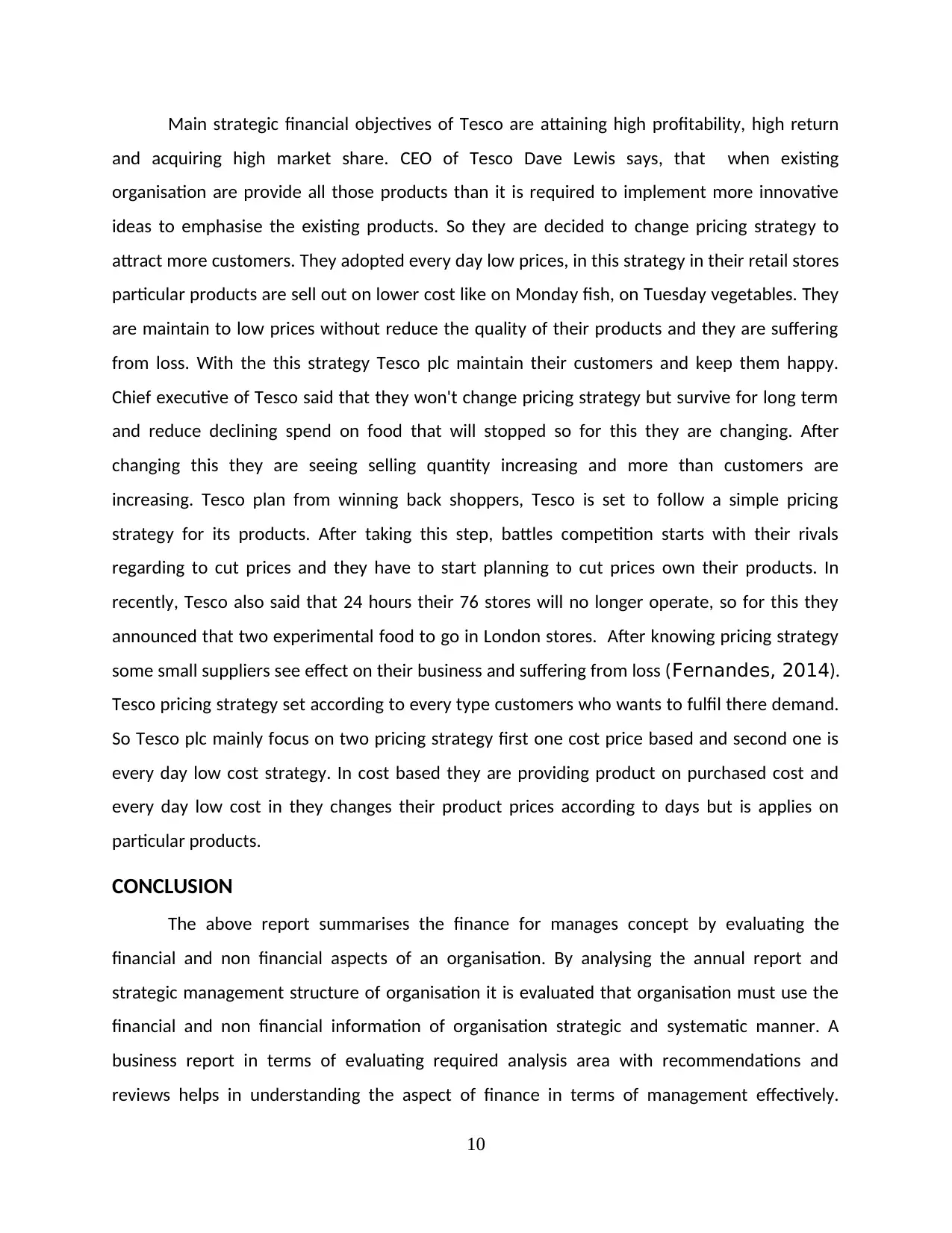
Main strategic financial objectives of Tesco are attaining high profitability, high return
and acquiring high market share. CEO of Tesco Dave Lewis says, that when existing
organisation are provide all those products than it is required to implement more innovative
ideas to emphasise the existing products. So they are decided to change pricing strategy to
attract more customers. They adopted every day low prices, in this strategy in their retail stores
particular products are sell out on lower cost like on Monday fish, on Tuesday vegetables. They
are maintain to low prices without reduce the quality of their products and they are suffering
from loss. With the this strategy Tesco plc maintain their customers and keep them happy.
Chief executive of Tesco said that they won't change pricing strategy but survive for long term
and reduce declining spend on food that will stopped so for this they are changing. After
changing this they are seeing selling quantity increasing and more than customers are
increasing. Tesco plan from winning back shoppers, Tesco is set to follow a simple pricing
strategy for its products. After taking this step, battles competition starts with their rivals
regarding to cut prices and they have to start planning to cut prices own their products. In
recently, Tesco also said that 24 hours their 76 stores will no longer operate, so for this they
announced that two experimental food to go in London stores. After knowing pricing strategy
some small suppliers see effect on their business and suffering from loss (Fernandes, 2014).
Tesco pricing strategy set according to every type customers who wants to fulfil there demand.
So Tesco plc mainly focus on two pricing strategy first one cost price based and second one is
every day low cost strategy. In cost based they are providing product on purchased cost and
every day low cost in they changes their product prices according to days but is applies on
particular products.
CONCLUSION
The above report summarises the finance for manages concept by evaluating the
financial and non financial aspects of an organisation. By analysing the annual report and
strategic management structure of organisation it is evaluated that organisation must use the
financial and non financial information of organisation strategic and systematic manner. A
business report in terms of evaluating required analysis area with recommendations and
reviews helps in understanding the aspect of finance in terms of management effectively.
10
and acquiring high market share. CEO of Tesco Dave Lewis says, that when existing
organisation are provide all those products than it is required to implement more innovative
ideas to emphasise the existing products. So they are decided to change pricing strategy to
attract more customers. They adopted every day low prices, in this strategy in their retail stores
particular products are sell out on lower cost like on Monday fish, on Tuesday vegetables. They
are maintain to low prices without reduce the quality of their products and they are suffering
from loss. With the this strategy Tesco plc maintain their customers and keep them happy.
Chief executive of Tesco said that they won't change pricing strategy but survive for long term
and reduce declining spend on food that will stopped so for this they are changing. After
changing this they are seeing selling quantity increasing and more than customers are
increasing. Tesco plan from winning back shoppers, Tesco is set to follow a simple pricing
strategy for its products. After taking this step, battles competition starts with their rivals
regarding to cut prices and they have to start planning to cut prices own their products. In
recently, Tesco also said that 24 hours their 76 stores will no longer operate, so for this they
announced that two experimental food to go in London stores. After knowing pricing strategy
some small suppliers see effect on their business and suffering from loss (Fernandes, 2014).
Tesco pricing strategy set according to every type customers who wants to fulfil there demand.
So Tesco plc mainly focus on two pricing strategy first one cost price based and second one is
every day low cost strategy. In cost based they are providing product on purchased cost and
every day low cost in they changes their product prices according to days but is applies on
particular products.
CONCLUSION
The above report summarises the finance for manages concept by evaluating the
financial and non financial aspects of an organisation. By analysing the annual report and
strategic management structure of organisation it is evaluated that organisation must use the
financial and non financial information of organisation strategic and systematic manner. A
business report in terms of evaluating required analysis area with recommendations and
reviews helps in understanding the aspect of finance in terms of management effectively.
10
⊘ This is a preview!⊘
Do you want full access?
Subscribe today to unlock all pages.

Trusted by 1+ million students worldwide
1 out of 14
Related Documents
Your All-in-One AI-Powered Toolkit for Academic Success.
+13062052269
info@desklib.com
Available 24*7 on WhatsApp / Email
![[object Object]](/_next/static/media/star-bottom.7253800d.svg)
Unlock your academic potential
Copyright © 2020–2025 A2Z Services. All Rights Reserved. Developed and managed by ZUCOL.





